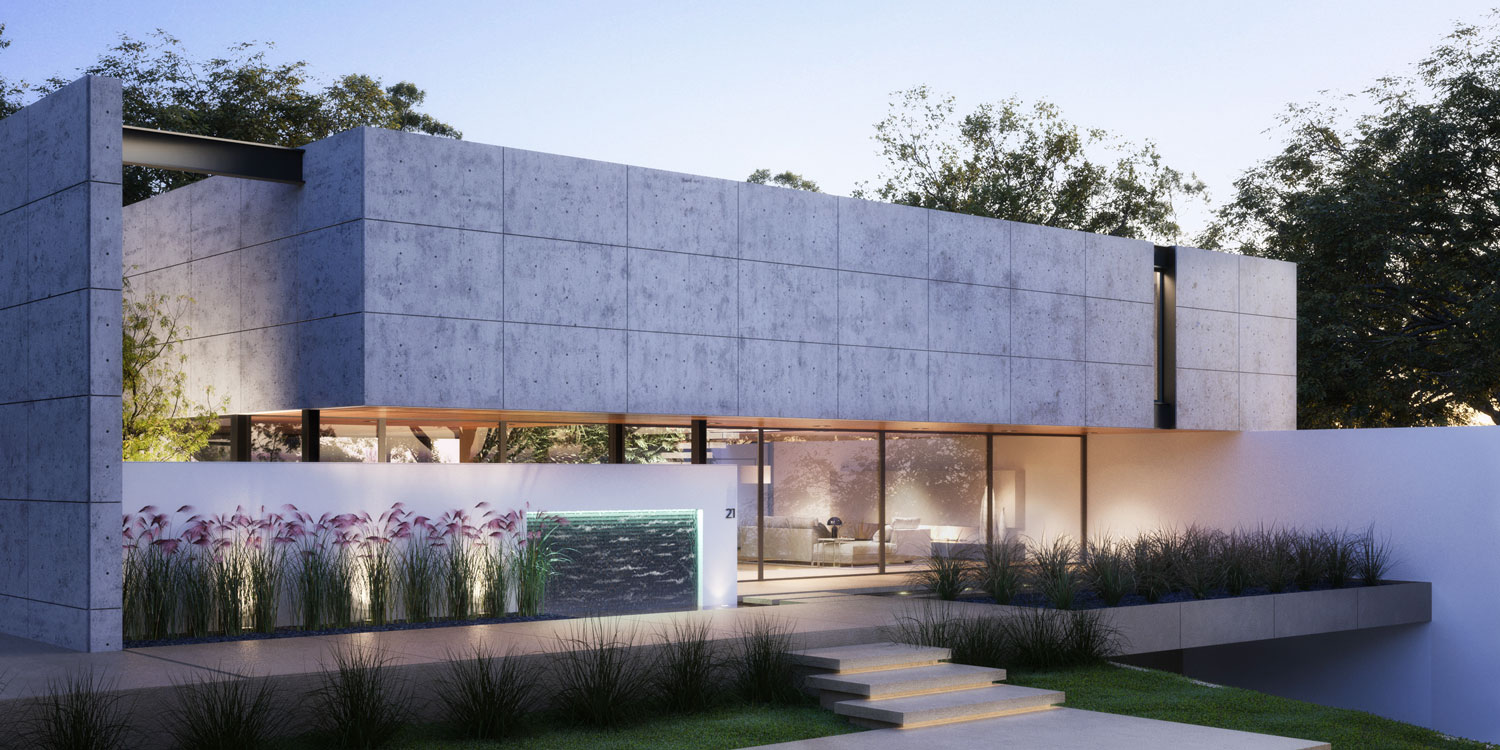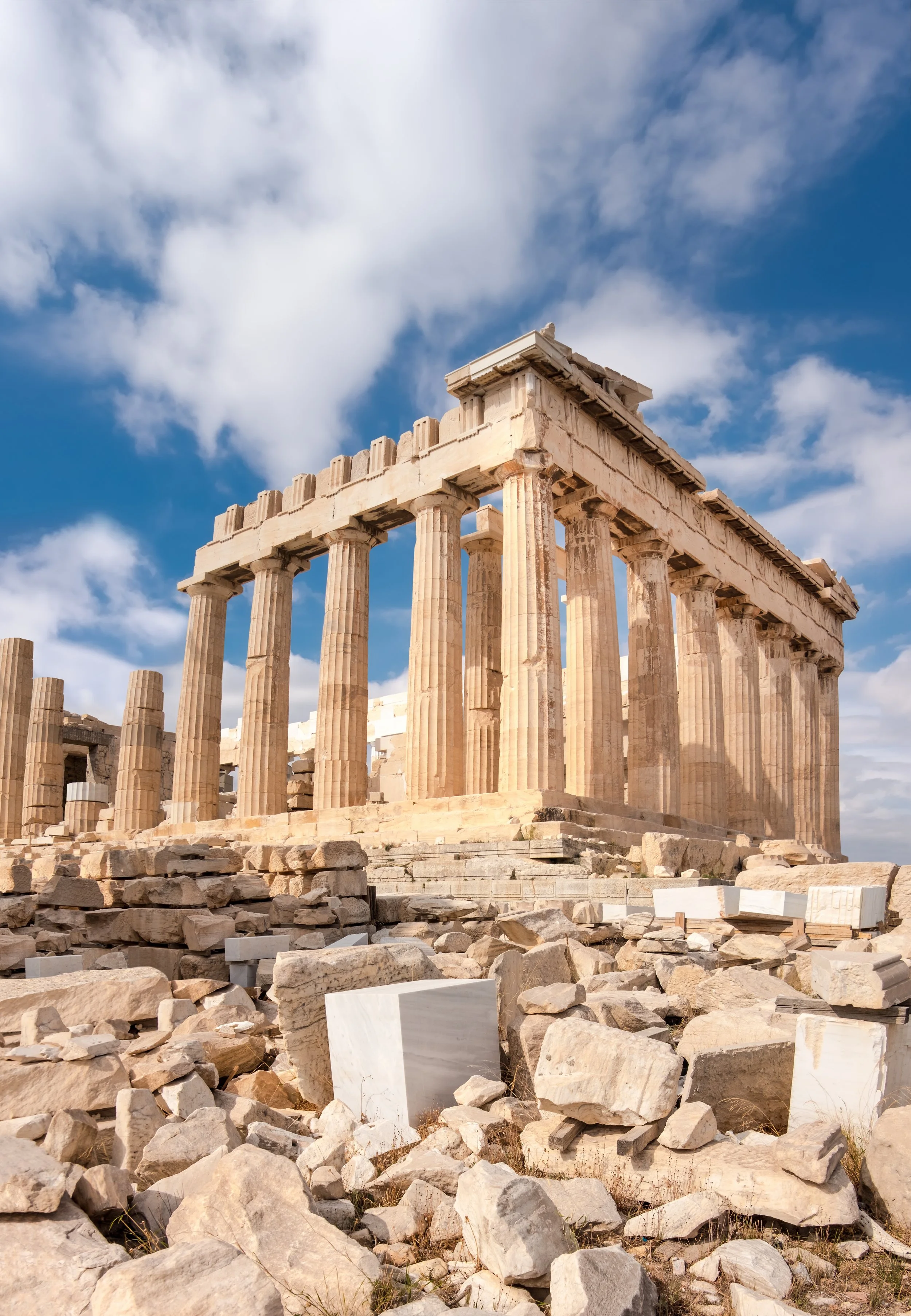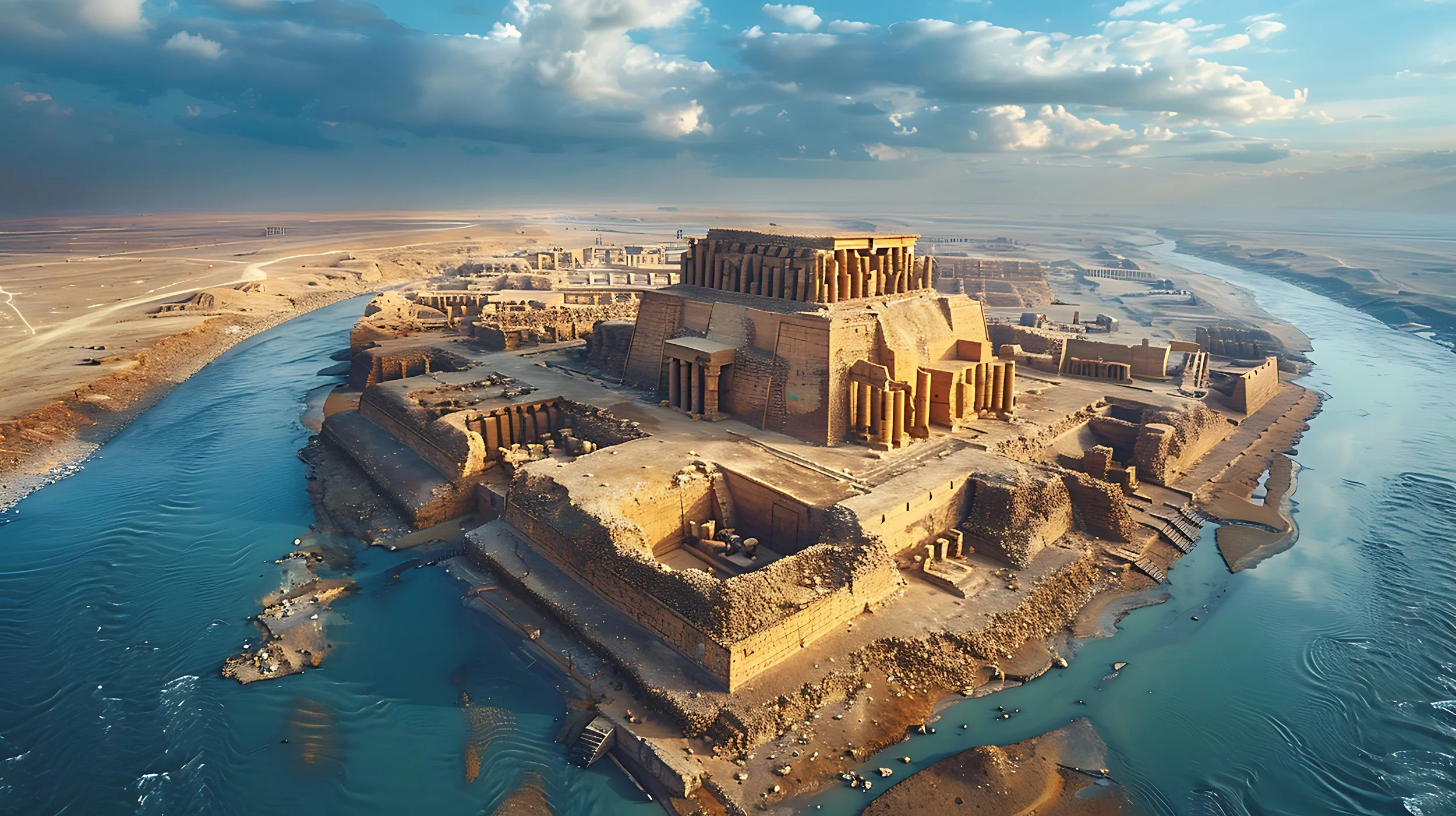Documentary | The Roman Baths in Bath, England
I want to take you on a journey back in time. In the southwest of present-day Britain, near a bend in the River Avon. Here, the natural geological process has dispelled warm, mineral rich water from deep within the earth for thousands of years. The ancient people who inhabited this area believed these healing and mystical waters were a gift from the gods.
Since then, the people in the area have coveted the mystical waters. This is the story of how these hot springs influenced the course of history that ultimately led to the growth of a unique cosmopolitan city in the southwest of England. Named after its healing waters. This is the story of the Roman Baths.
Mitchell: Hi, my name is Mitchell Rocheleau. Today I'm in Bath, England at the Roman Baths. I had a discussion with Allan Crossley, historian here at Bath, about the history and the chronology of the site. I hope you enjoy it.
So take me through the history of the spring. Is it fair to call it a hot spring?
Allan: Oh, absolutely.
Mitchell: So hot spring. So this was there and you had the local tribal people in the area. They found this kind of a mystical, spiritual spring. What did that scene look like back at that time?
Allan: Evidence of interaction with the water is present 4000, 5000 years. It's difficult to pin the Celtic peoples down to one specific group, but luckily they were known as the Dobunni. And this local area. It would have been little more than a swamp. So a large marshy ground, the river regularly flooding the springs, constantly bringing up this hot water and most likely there would have been wooden structures. Okay, so we haven't got evidence on this, but this is what I have to estimate, simply because we do know that there were offerings thrown in. They show that people were interacting with the water, maybe hoping for a successful hunt, thanking spirits of the local area for a good harvest.
Mitchell: These early people would have seen the warm steam rising off of the water's surface when it was first discovered. The warm water would have had a slight sulfuric smell and red or orange coloration, just as it does today. This would have been a perplexing tree and perhaps frightening sight. Without contemporary knowledge of geology and science, the Dobunni people began attributing mystical powers to the site, personifying the natural process through the existence of gods for the Dobunni people, Sulis presided over healing wells and waterways.
Allan: The goddess was pleased to be present within the spring, and so the spring waters represent a form of our interaction. By offering into the spring, it would mysteriously or magically or divinely move to the goddess and the divine world, that mysterious world beyond our comprehension.
The word Sulis has similar origins to the Celtic words for eye or a gap, a liminal space between our world and the spiritual nature of the divine world in the unknowable realm beyond our comprehension, yeah.
Mitchell: The natural hot springs at Bath are part of a more extensive, intricate and rare geological process. Rainfall seeps into the Earth's surface in Mendip, a range of Carboniferous limestone hills south of present-day bath. The water slowly seeps into the earth through the layers of limestone, about 8,000 feet, down into the Earth's crust. It is warmed by the internal heat in a geothermal effect.
Allan: A lot of people will assume because it's hot water like, say, in Iceland. The water is volcanic, but it's a steady stream which simply constantly reemerges in this location, having fallen on the Mendips. Over 1,000,000 liters of water emerging in this location every single day.
Mitchell: I had the opportunity to speak with Peter Davenport, an archeologist and architectural historian who has been involved firsthand with many of the excavations since 1980.
Peter Davenport: What seems to be the case is the rain falling on those limestone hills soaks through the porous limestone down to a solid strata several hundred feet down below the ground, flows in, in the porous limestone above the non-porous layer. Then it finds a fault, which happens to be where Bath is now, thought leading up to the surface, a crack in the stonework and the pressure of all the rock on top forces to water up through that crevice, through that crack over there's sheared a small series of cracks and crevices, and then it pops up in the middle of Bath.
Mitchell: The result is a natural hot spring or bath temperature water spills out into the earth between 40 and 50°C, depending upon the discharge point.
Peter: It's the pressure of the rocks above that water that keeps it hot. If you were to just jump straight into the main spring where it comes up at full temperature, you jump out again. It's, it's very hot. But it cools down quite quickly. The Romans were quite clever at that. They, in the reservoir that they built around the main spring, the king's bath, they let the water flow through gravity quite slowly into the great Roman swimming baths, and then into two other baths further on, cooling as it went. And so the great swimming baths, if you go in at one end where the hot water comes, it’s pretty warm, pretty hot. But they are able, because it's cooled slightly as it's running through the channels, go to the other end and it's lukewarm, you know. So you can choose which temperature you like.
Mitchell: The water contains calcium, sodium, potassium, magnesium, hydrogen carbonate and chlorine.
Allan: What we think, and we can't prove it, just because we can't start the process by dropping in a dye to start the water flowing through and see where it emerges and where it starts from, and how long it takes to process through metal, simply because it could take between 3,000 and 6,000 years. But the water is falling as rain, possibly on peoples who hadn't even invented iron yet.
Mitchell: It's fascinating to think that the water emerging in Bath today is water that fell thousands of years ago. When you touch the water of Bath, you may be touching the water that fell out of the skies on our ancient prehistoric ancestors. When the Romans invaded Britain around 43 A.D. under the emperor Claudius, it marked a significant turning point in the history of Britain. They established roads connecting many of the area's native settlements, and Bath was the location where several of these roads converged.
Allan: Well, the Romans were trading with Britannia in the first century B.C., going back many centuries. So, there's led work which was found here that actually dates to Pompeii.
Mitchell: When the Romans discovered the hot springs, they probably saw a semi-natural bog surrounded by hills filled with steam hovering over the surface of the wetlands.
It was not long before the Romans had the idea to build a bathhouse on this site and exploit the natural resource, the bathhouse concept was not new to the Romans. Bathing was a central part of Roman culture and daily life. When they discovered the hot springs, it's easy to see how they would have thought it had excellent opportunity to construct a bathing complex.
The Romans took a building type that they were very familiar with in Rome and they found a natural hot spring here and just said, “Oh, this sounds fantastic. We don't have to heat the water. You know, we could just build our complex. We're familiar with this building type and, you know, take our formula and then put this here.”
Allan: Absolutely. To heat up water, especially in the Roman world, is inordinately expensive. To be able to entice people to come to trade, to join military expeditions and protect and to explore Britain, temples like this, baths that have such renowned and sacred spaces, really emphasize the opportunity that Rome can enable by its legislation.
Mitchell: Construction and assembling the resources for this scale building campaign is no small task. At the time, Britain had no traces of an organized building industry. There was no infrastructure to support the construction. Therefore, it would need to be organized and managed from the ground up.
Quarries had to be opened, sand transported, and lime burnt for the mortars and plasters in the building. Kilns needed to be built to fire the bricks and tiles. Pits to extract the clay needed to be dug, lead for the shell of the baths in it to be mined. They would also need large quantities of timber for fuel and framing. An entire ecosystem needed to be created.
The location for the bathhouse and the temple was planned around the location of the Great Spring, which was the primary spring that the Romans chose to control and use for the project. They could not build in the area until the spring was contained, and they could try the surrounding area to make it a suitable building site.
Allan: To be able to build any of the city, the first thing is to encapsulate the springs, then to drain the swamp, to create foundation material, possibly hay bales, possibly stakes with hay bales, which, due to the lack of oxidation, could potentially still be the same material which is supported in the city's lake.
Mitchell: They began by constructing a series of drainage tunnels to remove the excess water from the site. The primary drain constructed is referred to as the Great Drain. It is large enough for a person to walk upright through in order to clean and remove excess silt, so the drain system would not clog. The Great Drain ultimately terminated and discharged any excess spring water into the River Avon. After the drain was completed, they began constructing a reservoir where the Great Spring discharged from the earth.
It was lined with lead sheets, and the water from the spring entered through natural fissures in the base. In addition, the reservoir had a sluice or gate that when open, controlled, and channeled water into the bathing complex. The sluice was above the drainage overflow, so that when the overflow vent was blocked, the water in the reservoir accumulated until it reached the sluice and it was channeled into the baths.
The reservoir also acted as a gravity silt filtration system. The Romans knew that when the water from the spring bubbled up from the earth, it brought millions of tiny silt particles, which over time would clog the drainage and bath system of the complex. To minimize potential clogs, the reservoir was constructed several meters deep so that when the water bubbled up, the silt particles would only reach so high before they fell back down at the bottom of the reservoir.
Clean water on top, free from any silt, was then the water that was able to be used and entered the sluice, traveling into the bathing complex. Once the spring was controlled into the stone reservoir and the area drain, construction of the building that would house the baths could begin. The architecture of the building that enclosed the baths resembled the form of a Roman basilica.
The Great Bath was under the nave or central portion of the basilica plan. As this area had the highest roof and most volume. The roof structure above, in its earliest days, would have been wooden, whereby it would have been replaced by an enormous masonry vault. Construction of the large masonry vault occurred in the third period of the bath complex’s evolution.
Allan: So, you might be able to see just at the opposite end, underneath the stairs there's a lead pipe. This lead pipe is original. It would have facilitated the entire structure. It's carrying cold water in this example, but certainly there would have been other pipes channeling hot water around the site and its plumbing. The Latin word plumbum is where we get our plumbing from, usually because the Romans used so much of it in plumbing facilitates in the transport of water.
Mitchell: One of the most technically impressive components of the great bath is its lead lining. The Romans mined and constructed large lead sheets about 1 to 2 inches thick, that lined the bottom of the pool to contain the water and help to prevent the water from percolating down to the earth below. The stone steps on all sides of the Great Bath led down to the water. This is an engineering marvel for the time.
Peter: Baths is lucky in Roman building terms, in that there’s a lot of local resources around. About 50 miles to the south are lead mines, and there's a lot of lead to line the baths and probably to use in the roofs though we can't be sure about that, certainly for gutters and things like that. And when the Roman army took over, those were exploited, used those lead mines almost immediately. I mean, whether in 10 or 15 years of the conquest, the Roman army were down around the area, built themselves a fort and a small settlement for workers and they were exploiting the lead very soon. And of course, lead we forget, was for the Romans actually a source of silver, lead always has a small amount of silver in it, and lead, to the Romans, was a byproduct of silver making. A big byproduct, because you make much, much more lead out of the ore than you did silver. The silver was valuable. It was a government monopoly.
Mitchell: In 1727, a local construction team dug a sewer trench on Stall Street. Near the baths. They discovered a bronze head statue of the Roman god Minerva. Minerva was their god of wisdom and curative powers, suggesting their belief that the spring had natural healing capabilities. When the Romans occupied the site, they would have most likely asked the local Celtic tribes which God presides over the springs. The Romans thus merged the Celtic and classical deities into the goddess Sulis Minerva. The waters were then called Aqueous Sulis Minerva, the waters of Sulis Minerva.
Allan: This location has a natural source of hot water. It has the temple dedicated to the goddess of the spring and political side of why that temple is here is quite interesting. The spiritual nature probably was enough for the Romans to say, “right, we'll we'll take that” and remember, not everybody supported the occupation. So this is a way of the Romans saying, “you local natives, don't forget what we can build, what we can construct.” And if we can construct this, what else we can achieve? If you support the Empire, then you can enjoy these same luxuries, these facilities. And it's a social center.
It's somewhere where people can come chat, talk about the price of olives or the latest gladiatorial contests. It's a way of bringing society together. The local tribes would have been welcome. They would have sat here. Farm workers, people who'd previously held sword and shield against the occupation alongside the generals, the priests, the bakers, the civilians of the cities.
But in its core element, a temple complex with great bath facilities, sauna, steam rooms, hot tubs, cold tubs, gymnasium, shops to sell souvenirs, to buy wine, to buy oysters, to celebrate the moments of life and changing of the seasons.
Mitchell: One of the most revealing elements discovered during the excavation of the baths was over 100 small lead tablets, some folded and inscribed with wishes and curses from the bath patrons.
Peter: We excavated in the first phase, 130 of them. Now these tablets, they're quite small. They're, they're about the size of a small letter envelope. And we notice that in smaller than a postcard, they're actually put in some extra tin and lead, you can call it lead if you’d like or it's a soft metal. It's gray. And when you scratch into it with a stylus, a pointed writing instrument, you scratch the letters into the lead and the silver underneath shows up as lettering. It's kind of magic legend because these letters are written backwards like a mirror writing. Sometimes in mirror writing, you like to read it from right to left, other times in mirror writing you lead from left, read from left to right, but the letters were reversed. Obviously this this is kind of magical because it means the goddess can read this but if somebody else by chance sees your letter, they can't easily see what it says. And, it took a very specialized, highly qualified guy called Roger Tomlins to read these, these curses over a period about two, three years after they were excavated. We see on nearly all the others, had either DSM or DLSM scratched into the metal work that’s Dea Sulis Minerva which means “this belongs to the goddess Sulis Minerva.” Roman religion was a bit transactional, you know. You asked a god for a favor, and you promised them you’d do something in return or the other way around. You saw, “do this if you did this for me.” So many of the curses, what we call, the lead plaques that people were written on and thrown into the spring, are kind of prayers, to the goddess, to do something for them, in most cases to find or return stolen goods or punish the person who stole them.
One, curse is also known from about 30 miles away in another Roman site called Uley Temple, where a man of the same name makes a request to the gods there, is Mercury, in handwriting that could be matched up to the tablet he left here, making a request to the goddess, Sulis Minerva, so that’s someone who wrote his own letter, as it were, to the goddess here, and also wrote a similar one up in Uley, hedging his bets to which god or goddess would help him out best near their treasure trove of interest.
Mitchell: With its healing powers, religious shrine and spa, the city of Bath became a location where retired Roman soldiers would retreat and spend their remaining days enjoying the luxuries and health effects of the natural waters.
Allan: There's a lot to say for a bathhouse. The idea that we socialize here in a cleansing environment rather than in a pub where we get rid of all our problems of the day, the through the catharsis of beers and spirits. Neat as the time would have been.
Mitchell: They would have moved around the baths complex, go to the gym, cold plunge, the hot pool.
Allan: Certainly. Yeah. So, the bathing process: gym, changing room, treatment room, a tepid area, a warm room where we don't really sweat, but we're already sweating because of the exercise. We might receive treatments, spa therapy, such as massage, using oils and perfumes. Then the sauna room, the cold area and scalding hot room where we sweat even more. And the olive oil, usually olive oil that will act as an antibacterial and a moisturizer. The sweat and the oil is then scraped away using a device called a strigil or scraper, strigil. And that process then removes toxins from the body, but also cleanses, cleanses the skin.
Mitchell: Interesting, exfoliates.
Allan: Exfoliates.
Mitchell: Okay.
Allan: And ended that process of course once the oil is removed is the cold plunge. Not everyone would, some people would simply access a cold environment, sit down, cool down naturally, and enjoy socialization. Chatting.
Mitchell: The baths were used for nearly four centuries until the Romans left Britain around the fifth century A.D.. Over time, they fell into disrepair and were slowly forgotten.
Allan: And see this, kind of straightedge? I twisted my ankle multiple times when I first started this job. There's two stories that I tell. One is that, after the collapse of the Roman Empire and the collapse of the Roman building, the structure fell into disrepair. And what we see is the repurposing of the building. So it's entirely possible that the ditches that we just crossed, those are simply due to rainwater gradually eroding over the path, gravel, stone rumbling through, causing that very smooth surface. The other story that I tell, and it's a little bit interpretive because a lot of archeology is interpretation, it's the fact that we found a lot of oyster shells in that corner over there. And where we just passed over here, broken pottery stained with wine.
Now, you might have noticed that that ditch was relatively straight and relatively smooth, and it also had a curvature. It's entirely possible that there was a table, that there was a table where people were chewing and these Roman visitors wearing hot old sandals, sometimes with iron nails in the, in the bases. These would have gradually caused the erosion of the floor, and potentially leather shoes. But the more elite come across and they start to smooth the floor and gradually that surface then wears down. And obviously where it's a curvature, it's because people are leaning on the bar. They're pushing the bar, waiting for their glass of wine, their goblet of wine. And then once they've drunk, they stumble away. And the curvature of the line, proves the path of where those Roman drinkers were walking.
Mitchell: I like the second story better.
Allan: Yes, yes, yeah.
Mitchell: Generations of rubble, flooding and new buildings slowly engulf the Roman baths complex until it was rediscovered in the 18th century. If you visit the Roman Baths today, you will notice that the main pool seems curiously lower than the adjacent modern day streets. The elevation of the original Roman Bath would have been built on the natural grade at the time.
Over the years, as development in the city occurred, the previous civilizations ruins were built over and covered, thus elevating the level of the town. Today, we can see three primary striations that depict the three main development eras.
Allan: We're looking at layers which don't necessarily make sense. So, we've got Roman at this level, which when we've got Victorian from the excavations, of the mid to late 19th century, and then we've got Georgian from the top street level, which is 17th and 18th century.
Mitchell: Interesting, so layers.
Allan: Exactly. Yeah. But it does make sense because the, the modern Georgian was then excavated by the later Victorian and they discovered the previously existing Roman. So we're standing on the Roman level, which is natural ground level, and everything else is just built up on stilts, more or less, and shoulder height and downwards is Roman.
And this honey colored rock. This is from the excavations of the 19th century, the Victorian community. So, each community is building on the, foundations from the ruins of the Old City’s. This Roman level. It was turned into a monastery. The monastery was torn down. The Normans built a farming community, but gradually fell into disrepair. In Shakespeare's time, the city was mostly made of wood, and again, that whole city was torn down in order to enable the modern Georgian city of Baths.
Mitchell: About what time was this date roughly, was this the upper level built?
Allan: So this upper level, this certainly would have been in the form that we see it now, today in the turn of the 20th century. So, 1900s. Absolutely. This area is open 1910’s, it would have been accessible as we see it now.
Mitchell: To give us an idea of scale roughly: So the Roman structure, do we know how high that would have?
Allan: Oh yeah. Yeah. This is really a stand in the landscape. So, as far as we're no longer standing at ground level, the base of the, the Baths, the building actually stretched as high as this second archway.
Mitchell: Wow.
Allan: It's quite a, this really is a large vaulted space, the rafters where your thoughts can echo and certainly light would have flooded in, but the bath itself would have been lit primarily by torchlight.
Mitchell: Wow.
Allan: Believed the only purpose for this structure in the way that I've described it, with that large vaulting ceiling, is to emphasize how competent the Roman, ability of the engineers, the structures of this site actually were.
Mitchell: Today, the baths remained a destination for people worldwide. The natural geological process at Baths still fascinates and attracts us. Baths is designated as a UNESCO World Heritage Site, attracting over 1 million visitors annually.
If you visit the Roman Baths today, they're open for public viewing. However, you cannot bathe in the original pools. In 2006, a separate modern bathing facility that uses the same thermal spring was open for the public to enjoy the rich heritage of bathing in the city of Bath.
Mitchell: Well, Allan, thank you so much for all the knowledge you've bestowed upon us.
Allan: I suppose, yeah. Good talking with you.
Mitchell: Thank you.
The Roman Baths: https://www.romanbaths.co.uk/
Special Thanks to The Roman Baths & Historian Allan Crossley































Rome's history is often presented as a glittering metropolis full of architectural excellence, sophisticated engineering, extensive paved roads, and glorious monuments. Our contemporary entertainment industry romanticizes the tales of Roman emperors, warriors, gladiators, and politicians. When we visit the ruins, we imagine the daily life of ancient Rome as a pageant of prosperity and industriousness that supported the growth of an ancient utopia. These aspects and portrayals of Rome have a degree of truth behind them. However, a darker side of Rome managed to evade the limelight.